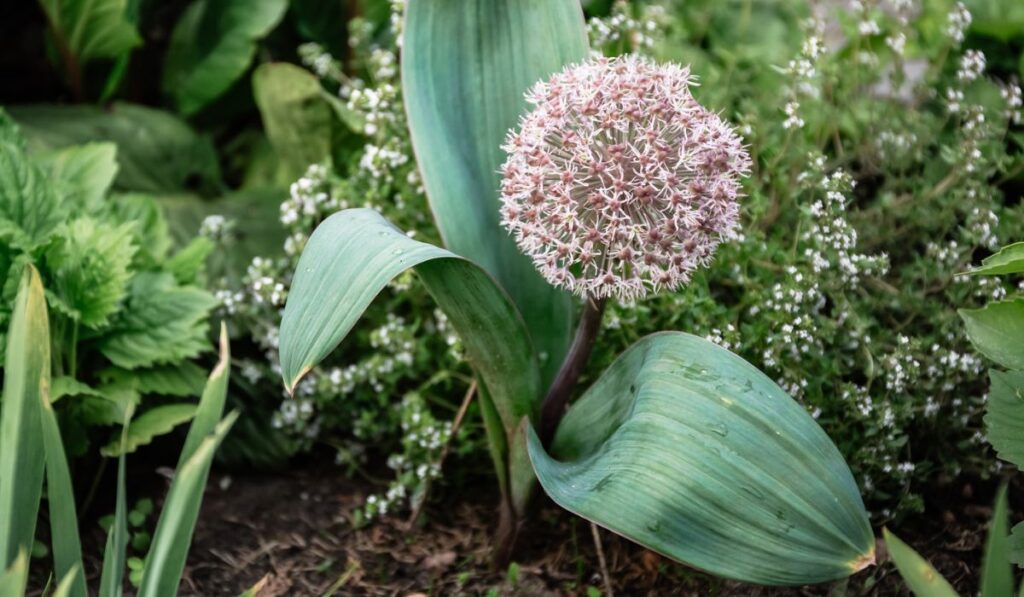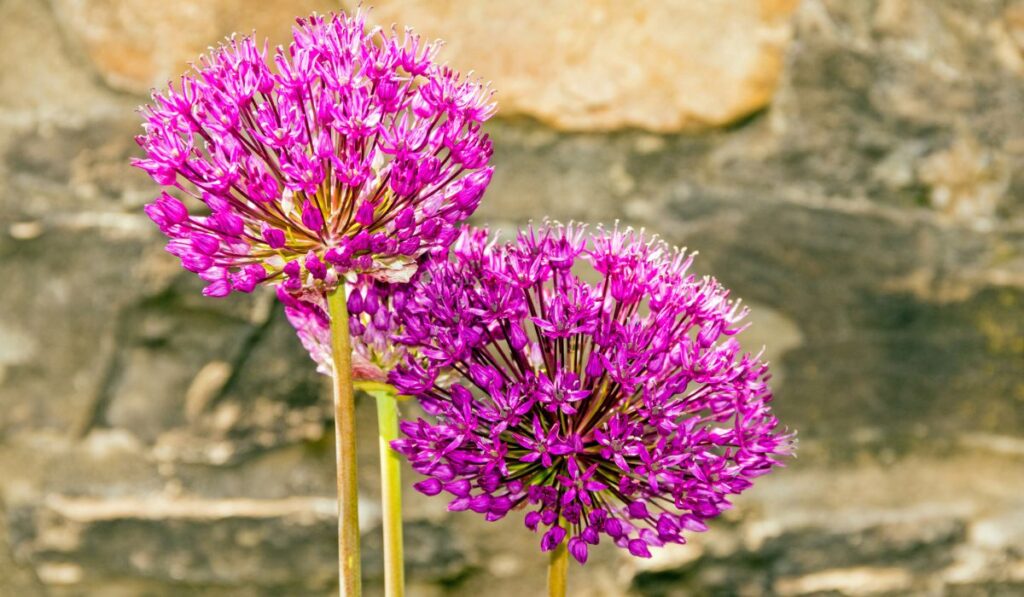Boasting large rounded bunches of vibrant purple flowers and attractive seed heads, allium bulbs are bold, visually complex, and a lovely addition to your garden. You can plant them with feathery grasses or weave them through colorful, sunny garden borders for the best effect. Along with being attractive to pollinators, these resilient plants are excellent for cutting as well. But when’s the right time to plant allium bulbs?
It’s best to plant Alliums during the fall, between September and November. Make sure you place them in free-draining soil and in an area that receives lots of sunlight. They don’t need any special care, and you can even plant them in large clusters for a more magnificent display.
Before you start planting allium bulbs, it’s important to choose the right color and size of the flower. Alliums come in varying shades of blue, mauve, white, purple, pink, and yellow, while the size of their flower head can range from less than an inch to 7-8 inches in diameter. Let’s look at the best time to plant alliums, how to properly plant them, and what you can do to ensure steady, stable growth.
When Should You Plant Allium?

Alliums are one of the easiest flower bulbs to plant. They tolerate most types of soil and are hardy down to USDA zone 4.
You should plant alliums in fall between the months of September and November but before the ground freezes. Since they thrive in dry conditions, you won’t have to worry about watering the bulbs regularly.
Plant them in a sunny area, water them after placing them in the soil, and then just sit back and wait for the flowers to bloom in late spring or early summer.
How to Plant Allium
It’s better to plant alliums in a spot that receives full sun, as the bulbs develop stronger stems under brighter light. Before you start planting, dig into the soil a bit and clear away any weeds.
It’s also advisable to avoid planting in freshly manured soil, as it might be too nutrient-rich for allium bulbs.
Planting in Borders
If you’re planning on planting your allium bulbs in borders, keep the smaller flowers around three to four inches apart, while it’s advisable to leave at least eight inches of space between the taller species.
Planting in Containers
Most allium bulbs thrive in deep pots. You can either plant them in a high-quality peat-free potting compost or add equal parts peat-free multi-purpose compost and John Innes No. 3 to your pot.
You can also place the allium pots behind other plant containers to cover the fading foliage.
Where Is the Best Place to Plant Allium Bulbs?
For the best results, you should plant allium bulbs in a spot with free-draining soil and lots of sunshine. However, make sure that the area is sheltered, so the flower spikes don’t get blown over.
You can plant alliums in containers as well, but just make sure they have proper drainage holes. You should also keep the mature size of your selected species in mind, and then choose the container size accordingly.
Here are a few more tips that can help you determine the best place to plant allium bulbs:
- Don’t plant alliums in cold, waterlogged, or exposed conditions, as they can rot.
- If you see water puddles five to six hours after heavy rainfall, then it’s better to choose another spot or add organic material to the soil to improve its drainage.
- Don’t plant alliums in an area that’s regularly cultivated, as you can easily damage them when digging the soil.
- Allium leaves die during the flowering season, so it’s better to plant the bulbs in an area where their foliage is covered by other plants. Once the leaves die and fall down, you can easily remove them without damaging any of the surrounding plants.
How Many Allium Bulbs Can I Plant Together?
If you want a colorful, dramatic display, plant alliums in large clusters throughout the border, or just naturalize them in your garden. Keeping the bulbs six to eight inches apart and grouping them in fives or threes also gives them a more natural look.
The more elegant species of alliums look wonderful in containers and pots. You can place these flowers more closely together in your garden, but just make sure that each pot has good drainage and the bulbs don’t touch each other.
You can also add tulips, daisies, pansies, and other spring flowers to your allium pot for a brighter and more lively look.
How Deep Do You Plant Allium Bulbs?
It’s advisable to plant allium bulbs at least four times deeper than the size of the bulb. This usually translates to four to eight inches deep. Keep in mind that it’s better to plant alliums too deep than too shallow.
How To Look After Alliums
While alliums are incredibly resilient and don’t need a lot of care and maintenance, there are still a few things that can help ensure steady growth. Here’s a more detailed guide on how you can look after your allium bulbs:
Watering, Feeding, and Deadheading
Allium bulbs are drought-tolerant, and you don’t necessarily need to water them if you’ve planted them in the ground. They also don’t like summer irrigation, as it can result in the rotting of the bulbs.
However, if you’ve planted your alliums in containers, then you’ll need to water them regularly. Just make sure that the container has proper drainage, so the compost doesn’t become waterlogged.
When it comes to feeding, you don’t need to feed your alliums regularly. However, if the soil is poor, then it’s advisable to add balanced fertilizer (on Amazon) in the spring.
And don’t forget deadheading! While you can remove spent allium flower heads, the process is not necessary. In fact, dried flower heads look quite attractive in borders.
Winterizing
Alliums are extremely hardy, so they don’t need any additional care during winters. However, allium bulbs in containers are a bit more susceptible to the cold. Here’s what you can do to help protect them from the harsh weather:
- Move the containers or pots to a more sheltered spot.
- Place them in a greenhouse or a cold frame to shield them from the winter rain.
Caring for Older Alliums
If you think that the older allium bulbs are overcrowding your garden, simply lift, divide, and replant them once the flowers and foliage have died down.
Problems
Allium bulbs suffer from several diseases and pests, such as downy mildew, onion fly, and onion white rot. For this reason, it’s better to avoid planting alliums in spots where you’ve grown onion crops. It’s also advisable to keep an eye out for snails, allium leaf miners, and slugs.
Propagation
After a couple of years, your alliums will multiply. In certain cases, white bulbs will be pushed out of the ground. If this happens, carefully lift out the bulbs in early spring or late autumn and gently peel off and remove the offsets before replanting them straight back into the soil.
If you want to grow allium bulbs from seeds, collect the ripe seed from the plant and plant it right away. You can also purchase seeds online, like these Globemaster Allium Seeds by Seedville (on Amazon). However, keep in mind that using seeds is a very long process, and it might be years before you see a flowering plant.
Additional Tips and Tricks

- Cut a few of the brilliant blooms during the flowering season for drying or for a striking, vibrant flower arrangement.
- Don’t remove the foliage once the blooms have faded out. The leaves will use sunlight to make food, strengthening the allium bulb for the future.
- Cut away the foliage in mid-summer once the leaves die back and the plant becomes dormant. This clean-up will help give your plant a clean slate before it starts its next growing cycle.
- Add ground bark, decomposed manure, and compost to the soil as needed to prevent water-logging your allium bulbs.
- Expect the flower stems and more substantial top growth to arrive in spring. If you live in a warmer climate, you might see a few green sprouts in autumn.
